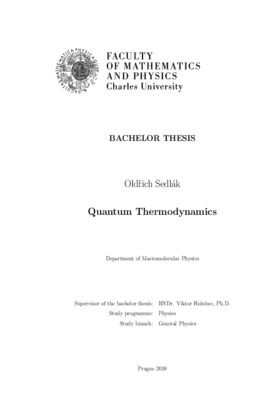Quantum thermodynamics
Kvantová termodynamika
bakalářská práce (OBHÁJENO)

Zobrazit/
Trvalý odkaz
http://hdl.handle.net/20.500.11956/101849Identifikátory
SIS: 167836
Kolekce
- Kvalifikační práce [11978]
Autor
Vedoucí práce
Oponent práce
Chvosta, Petr
Fakulta / součást
Matematicko-fyzikální fakulta
Obor
Obecná fyzika
Katedra / ústav / klinika
Katedra makromolekulární fyziky
Datum obhajoby
13. 9. 2018
Nakladatel
Univerzita Karlova, Matematicko-fyzikální fakultaJazyk
Angličtina
Známka
Výborně
Klíčová slova (česky)
kvantová koherence, kvantová termodynamika, otevřené kvantové systémyKlíčová slova (anglicky)
quantum coherence, quantum thermodynamics, open quantum systemsKvantová koherence se považuje za jednu z cest vedoucích ke zlepšení kvan- tových technologií. Tato práce analyzuje model kvantového tepelného motoru inspirovaného Dorfmanem a spol. (PNAS svazek 110 č. 8) za použití stan- dardní markovovské kvantové optické mistrovské rovnice v Lindbladově formě. Stacionární koherence v tomto modelu vzniká na dvou degenerovaných energet- ických hladinách a její vliv je výrazný při shodném natočení odpovídajících dipólových momentů přechodů. Při maximálním natočení je proud ve sta- cionárním stavu vysoce závislý na relativní fázi a jeví známky kvantové in- terference. Numerické výpočty naznačují možné zvýšení proudu nad klasickou limitu. 1
Quantum coherence is being viewed as a possible resource that could improve the performance of quantum technologies. This thesis analyzes a quantum heat engine model inspired by Dorfman et al. (PNAS vol. 110 no. 8) while using a standard Markovian quantum optical master equation in the Lindblad form. Steady-state coherence arises from the degeneracy of the two upper energy levels and its effects become significant for near-perfect alignment of the associated transition dipole moments. For the maximum alignment, the steady-state cur- rent becomes highly dependent on the relative phase and exhibits quantum in- terference. The performed numerical calculations show some promise of possible enhancement of the current above the classical limit. 1
